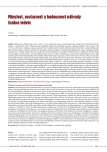The past, the present and the future of renal replacement therapy
Authors:
V. Tesař
Authors‘ workplace:
Klinika nefrologie 1. lékařské fakulty UK a VFN Praha, přednosta prof. MUDr. Vladimír Tesař, DrSc.
Published in:
Vnitř Lék 2011; 57(7&8): 603-606
Category:
136th internal medicine day, XXIV. Vanýskův den, Brno 2011
Overview
The observation that renal failure leads to ‘uraemia’ through retention of solutes that would otherwise be excreted by healthy kidneys, has been formulated as early as the first half of 19th century. The discovery of osmosis and a colloid membrane facilitated the first testing of dialysis, originally in animals and in the first quarter of 20th century also in humans. In the mid 1940s, dialysis became the method of choice for the treatment of acute renal failure. At the beginning of 1960s, the development of long-term venous access made programmes of chronic haemodialysis possible in many countries. These achievements, together with kidney transplantation, saved or significantly extended life of millions of patients with chronic renal failure. The last 50 years saw a dramatic increase in the number of chronically dialyzed patients; the safety and efficacy of haemodialysis methods improved and effective treatments have been introduced of a number of complications associated with chronic renal failure (e. g. hypertension, anaemia or bone disease). Despite this, mortality of, particularly older chronically dialyzed patients, is very high and their quality of life sometimes low. High cardiovascular mortality, frequently due to chronic heart failure and sudden death (unlike ischemic heart disease in healthy population), is a dominating problem. However, it is difficult to reduce the high cardiovascular morbidity and mortality of haemodialyzed patients. Patient prognosis might probably be improved by more frequent use of convective methods of blood purification and frequent haemodialysis as well as effective management of dyslipidemia. Nevertheless, early diagnosis of patients with chronic renal insufficiency and early management of all general as well as renal failure-specific risk factors in patients with mild to moderate chronic renal insufficiency is essential if the prognosis of haemodialyzed patients is to be improved. Future developments of renal replacement therapies are difficult to predict. The treatment should be individualized; early transplantation, peritoneal or home (frequent) haemodialysis should be performed in younger patients and conservative treatment, in addition to chronic haemodialysis, should be used in older patients. Miniaturization as one of the potential future trends could facilitate the use of portable artificial kidney. Artificial membranes coated with proximal tubule cells and ex vivo kidney cultivation represent another interesting perspective.
Key words:
renal replacement therapy – methods of haemosdialysis – cardiovascular morbidity
Sources
1. Cameron JS. History of the treatment of renal failure by dialysis. Oxford: Oxford University Press 2002: 1–345.
2. Matoušovic K, Rychlík I, Dusilová Sulková S. Hereditatis petitio české nefrologie. Praha: Tigis 2009: 1–455.
3. Herzog CA, Mangrum JM, Passman R et al. Sudden cardiac death and dialysis patients. Semin Dial 2008; 21: 300–307.
4. Eknoyan G, Beck GJ, Cheung AK et al. Hemodialysis (HEMO) Study Group. Effect of dialysis dose and membrane flux in maintenance hemodialysis. N Engl J Med 2002; 347: 2010–2019.
5. Locatelli F, Gauly A, Czekalski S et al. Membrane Permeability Outcome (MPO) Study Group. The MPO study: just a European HEMO study or something very different? Blood Purif 2008; 26: 100–104.
6. FHN Group. Chertow GM, Levin NW, Beck GJ et al. In-center hemodialysis six times per week versus three times per week. N Engl J Med 2010; 363: 2287–2300.
7. Davenport A, Gura V, Ronco C et al. A wearable haemodialysis device for patients with end-stage renal failure: a pilot study. Lancet 2007; 370: 2005–2010.
8. Ding F, Humes HD. The bioartificial kidney and bioengineered membranes in acute kidney injury. Nephron Exp Nephrol 2008; 109: e118–e122.
9. Ross EA, Williams MJ, Hamazaki T et al. Embryonic stem cells proliferate and differentiate when seeded into kidney scaffolds. J Am Soc Nephrol 2009; 20: 2338–2347.
10. Yokoo T, Kawamura T. Xenobiotic kidney organogenesis: a new avenue for renal transplantation. J Nephrol 2009; 22: 312–317.
Labels
Diabetology Endocrinology Internal medicineArticle was published in
Internal Medicine

2011 Issue 7&8
Most read in this issue
- Haemodialysis – the current practice
- Anemia and chronic kidney failure
- Immunosuppressive therapy and its problems
- Aetiology and a clinical picture of chronic renal failure
